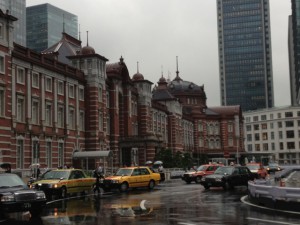ELSI Blog
22 Taxicab Culture in Tokyo and Manhattan1

Tokyo taxis
This blog will appear in two segments, the second half being uploaded next week.
Taxis are essential to urban areas, a concept that anyone needing to rush across town implicitly grasps. But did you ever consider how much the taxi ecosystem contributes to its city? What would Istanbul be without its Dolmus shared taxi system? How does London's impossible taxi exam, aka "The Knowledge," not only make for some seriously brainy taxi drivers, but also shape the London-ness of the city itself? Would Ho Chi Minh City appear as fast growing and modernizing (as opposed to modernized) without its ever expanding fleet of sparkling new (yet still dirt cheap) Vinataxis and Vinasuns? Ever flag down a taxi during election season in Taipei and be barked to state your political leanings, "KMT or DPP?!" only to be denied a ride if you are too pro-China or pro-Taiwanese independence for that driver's taste? Has anyone spent more than a week in cabs in Toronto and not had a foreign trained doctor (probably from Lahore) at the helm? And isn't this part and parcel of Toronto itself?
If taxis are, indeed, essential elements to the character of a city, then an unorthodox (though admittedly unprepossessing) way to approach a bewildering city is to simply immerse oneself in its taxi system. As an experiment, in the hope of gaining an insight or two into a city, let us try this out by comparing and contrasting two of the most complex cab cultures in the world, New York City's and Tokyo's.
Manhattan has had taxis for a long time. The first taxi company was Samuel's Electric Carriage and Wagon Company, which began running 12 electric hansom cabs in July 1897. NYC's first metered taxis appeared a decade later. Somewhat surprisingly, Tokyo was only five to fifteen years behind NY as metered taxis have been on the streets of Tokyo since 1912. The old term for a taxi was ippan jyokyaku ryokyaku jidosha (motor vehicle for passengers and travelers), while meters were called ryokin keijoki (adding receipts machines). Naturally the foreign terms takushii and metaa quickly took over. Over time the proliferation of taxis gradually led to the extinction of the jinrikisha (rickshaw pullers) and represent one marker of ancient Edo's evolution into Tokyo.
But let us take a quick ride to the present. Nowadays Japan's and NYC's taxi cultures have grown quite distinct. In Tokyo, when boarding or exiting a taxi, never, ever, open the door. Your white-gloved driver (the white-gloves are slowly disappearing) will operate a magical device on your behalf. If you open the door but more if you slam the door, said device will need a reset and the said driver, although mum, will not be pleased. Foreigners frequently forget this. Conversely, in Manhattan, Japanese tourists are known to leave their doors open after getting out of their cab. Like a good Japanese in NY, I myself recently got "Hey LADY!"-ed (in an accent of Indian subcontinent origin) as I stood like an idiot waiting for the door to pop open.

NY taxis
In fact, the NY cabbie's attitude to his passengers couldn't be more different from the Tokyo one. In Japan the passenger is royalty. Even when he has no idea where he is going, the driver will defer to the passenger's every command and/or take the optimal route to his destination. In the Big Apple, by contrast, every passenger is in danger of being looked upon as a potential source of extra money. An obviously foreign passenger can create a jackpot for an enterprising -- and amoral -- driver. Yet your New York driver need not obtain his 'extra money' nefariously. There is always the tip. New York drivers are known to deploy dozens of tricks to obtain larger tips.
I can't prove of its certainty but here's one of them: Start out your ride appearing sullen, slightly hostile, non-communicative and passive aggressive to your passenger, then incrementally cheer up, and make sure to be downright giddy at the end. This ersatz bipolar behavior creates an ever-rising opinion of the ride in the mind of your passenger. I start out with ultra-low expectations (Did he hear me? Does he care? Does he even understand?), transition to neutral (Hey, I can understand him. Wow, he actually speaks good English. Jeez, he's not such a bad guy after all), then, at then end, am hooked (Wow, who would've imagined Kabul to be such a hilarious place!) and watch those tips roll in (That guy was positively awesome!) Even though I've experienced this tactic repeatedly, my wallet and I fall for it each and every time.
By contrast, in Tokyo there are no tips, hence no corresponding need for the driver to endlessly strategize to put on a dog and pony show. Japanese drivers are polite because that is the way drivers are supposed to be. They are helpful because it is their duty. They chat with only if the passenger wants to. They keep their taxis immaculate because, well, this is Japan. It probably helps that the taxi company's corporate song espouses all these points, a morning chorus of service brainwashing before the shift begins.
Speaking of cleanliness, Tokyo drivers go to extreme lengths to ensure that the inside and outside of their cabs are spotless, almost to the finicky point of overriding the 'passenger is royalty' mantra. For example, I once was almost prevented from boarding a cab with a crate of wine. The driver must have felt that my box might get his back seat dirty. Only when I reluctantly agreed to put the box in the trunk was our ride back on.
Continuation of this blog will appear on Thursday.











